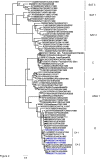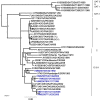Phylogenetic analyses of the polyprotein coding sequences of serotype O foot-and-mouth disease viruses in East Africa: evidence for interserotypic recombination
- PMID: 20731826
- PMCID: PMC2939557
- DOI: 10.1186/1743-422X-7-199
Phylogenetic analyses of the polyprotein coding sequences of serotype O foot-and-mouth disease viruses in East Africa: evidence for interserotypic recombination
Abstract
Background: Foot-and-mouth disease (FMD) is endemic in East Africa with the majority of the reported outbreaks attributed to serotype O virus. In this study, phylogenetic analyses of the polyprotein coding region of serotype O FMD viruses from Kenya and Uganda has been undertaken to infer evolutionary relationships and processes responsible for the generation and maintenance of diversity within this serotype. FMD virus RNA was obtained from six samples following virus isolation in cell culture and in one case by direct extraction from an oropharyngeal sample. Following RT-PCR, the single long open reading frame, encoding the polyprotein, was sequenced.
Results: Phylogenetic comparisons of the VP1 coding region showed that the recent East African viruses belong to one lineage within the EA-2 topotype while an older Kenyan strain, K/52/1992 is a representative of the topotype EA-1. Evolutionary relationships between the coding regions for the leader protease (L), the capsid region and almost the entire coding region are monophyletic except for the K/52/1992 which is distinct. Furthermore, phylogenetic relationships for the P2 and P3 regions suggest that the K/52/1992 is a probable recombinant between serotypes A and O. A bootscan analysis of K/52/1992 with East African FMD serotype A viruses (A21/KEN/1964 and A23/KEN/1965) and serotype O viral isolate (K/117/1999) revealed that the P2 region is probably derived from a serotype A strain while the P3 region appears to be a mosaic derived from both serotypes A and O.
Conclusions: Sequences of the VP1 coding region from recent serotype O FMDVs from Kenya and Uganda are all representatives of a specific East African lineage (topotype EA-2), a probable indication that hardly any FMD introductions of this serotype have occurred from outside the region in the recent past. Furthermore, evidence for interserotypic recombination, within the non-structural protein coding regions, between FMDVs of serotypes A and O has been obtained. In addition to characterization using the VP1 coding region, analyses involving the non-structural protein coding regions should be performed in order to identify evolutionary processes shaping FMD viral populations.
Figures







Similar articles
-
Genetic and antigenic characterization of serotype O FMD viruses from East Africa for the selection of suitable vaccine strain.Vaccine. 2017 Dec 14;35(49 Pt B):6842-6849. doi: 10.1016/j.vaccine.2017.10.040. Vaccine. 2017. PMID: 29102329 Free PMC article.
-
Diversity and transboundary mobility of serotype O foot-and-mouth disease virus in East Africa: implications for vaccination policies.Infect Genet Evol. 2010 Oct;10(7):1058-65. doi: 10.1016/j.meegid.2010.06.017. Epub 2010 Jul 7. Infect Genet Evol. 2010. PMID: 20619358
-
Development and evaluation of tailored specific real-time RT-PCR assays for detection of foot-and-mouth disease virus serotypes circulating in East Africa.J Virol Methods. 2016 Nov;237:114-120. doi: 10.1016/j.jviromet.2016.08.002. Epub 2016 Aug 27. J Virol Methods. 2016. PMID: 27575682
-
Analysis of Recent Serotype O Foot-and-Mouth Disease Viruses from Livestock in Kenya: Evidence of Four Independently Evolving Lineages.Transbound Emerg Dis. 2015 Jun;62(3):305-14. doi: 10.1111/tbed.12152. Epub 2013 Aug 12. Transbound Emerg Dis. 2015. PMID: 23931583
-
The history of foot-and-mouth disease virus serotype C: the first known extinct serotype?Virus Evol. 2021 Mar 19;7(1):veab009. doi: 10.1093/ve/veab009. eCollection 2021 Jan. Virus Evol. 2021. PMID: 35186323 Free PMC article. Review.
Cited by
-
Towards improvements in foot-and-mouth disease vaccine performance.Acta Vet Scand. 2020 May 20;62(1):20. doi: 10.1186/s13028-020-00519-1. Acta Vet Scand. 2020. PMID: 32434544 Free PMC article. Review.
-
Demonstration of Co-Infection and Trans-Encapsidation of Viral RNA In Vitro Using Epitope-Tagged Foot-and-Mouth Disease Viruses.Viruses. 2021 Dec 3;13(12):2433. doi: 10.3390/v13122433. Viruses. 2021. PMID: 34960702 Free PMC article.
-
A serological survey for antibodies against foot-and-mouth disease virus (FMDV) in domestic pigs during outbreaks in Kenya.Trop Anim Health Prod. 2014 Mar;46(3):575-81. doi: 10.1007/s11250-013-0530-0. Epub 2014 Jan 18. Trop Anim Health Prod. 2014. PMID: 24442573
-
A traditional evolutionary history of foot-and-mouth disease viruses in Southeast Asia challenged by analyses of non-structural protein coding sequences.Sci Rep. 2018 Apr 24;8(1):6472. doi: 10.1038/s41598-018-24870-6. Sci Rep. 2018. PMID: 29691483 Free PMC article.
-
Unrecognized circulation of SAT 1 foot-and-mouth disease virus in cattle herds around Queen Elizabeth National Park in Uganda.BMC Vet Res. 2016 Jan 6;12:5. doi: 10.1186/s12917-015-0616-1. BMC Vet Res. 2016. PMID: 26739166 Free PMC article.
References
-
- Belsham GJ. Translation and Replication of FMDV RNA. In 'Foot and mouth disease virus'. Curr Top Microbiol Immunol. 2005;288:43–70. full_text. - PubMed
-
- Coetzer JAW, Thomsen GR, Tustin RC, Kriek NPJ. Infectious Diseases of Livestock with Special Reference to Southern Africa. Cape Town: Oxford University Press; 1994. Foot-and-mouth disease.
-
- Domingo E, Escarmısa C, Martinez MA, Martinez-Salas E, Mateu MG. Foot-and-mouth disease virus populations are quasispecies. Curr Top Microbiol Immunol. 1992;176:33–47. - PubMed
Publication types
MeSH terms
Substances
Associated data
- Actions
- Actions
- Actions
- Actions
- Actions
- Actions
LinkOut - more resources
Full Text Sources
Other Literature Sources
Miscellaneous

